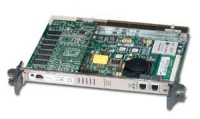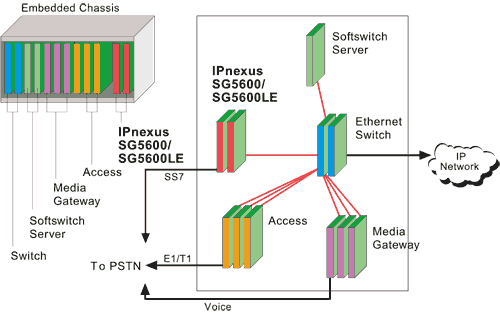SG5600 PICMG® 2.16-Compliant Signaling Gateway Blade
¤U¸üPDF
 The
IPnexus™ SG5600 Signaling Gateway Blade is a robust, turnkey SS7/IP signaling
gateway in a standard CompactPCI® form factor that also supports PICMG® 2.16. A
true carrier-grade system-in-a-slot, the Blade provides a signaling bridge
between traditional telephone networks and burgeoning packet-switched VoIP
architectures. When used in conjunction with softswitches, media gateways and
application servers, the Blade provides the SS7 "on ramp" functionality to
enable call control or service processing capabilities. Whether your SS7 network
is circuit-switched or IP-based, the Blade can meet your requirements for today
and well into the future.
The
IPnexus™ SG5600 Signaling Gateway Blade is a robust, turnkey SS7/IP signaling
gateway in a standard CompactPCI® form factor that also supports PICMG® 2.16. A
true carrier-grade system-in-a-slot, the Blade provides a signaling bridge
between traditional telephone networks and burgeoning packet-switched VoIP
architectures. When used in conjunction with softswitches, media gateways and
application servers, the Blade provides the SS7 "on ramp" functionality to
enable call control or service processing capabilities. Whether your SS7 network
is circuit-switched or IP-based, the Blade can meet your requirements for today
and well into the future.
Highlights
-
"Load and Go" SS7/IP signaling gateway on a blade
-
Standards-based IETF SIGTRAN IP/SS7 protocols
-
Reliable and robust software and hardware
-
PICMG 2.16-compliant
-
H.110 bus support
Features
Compact, Low-Cost System-in-a-Slot
The Blade boots locally from onboard Flash, making it
independent of the system controller. It enables system designers to easily
integrate signaling gateway applications yet benefit from the lower production
costs associated with embedded solutions. Sized to grow with your needs, the
Blade can be licensed for eight (SG5600LE) or 16 (SG5600) SS7 links using T1 or
E1 SS7 interfaces. IP connectivity may be provided via the backplane to Ethernet
switching equipment. Fitted with dual Ethernet ports, it can also support
redundant IP external connectivity for the latest SS7/IP interworking protocols.
Supports Latest SS7 over IP Protocols
As a stand-alone unit, it can be easily integrated into
equipment vendor solutions, separately terminating up to eight or 16 SS7 links
on a single unit and providing an IP interface to softswitches or service
applications. Our signaling gateways support the latest IETF SIGTRAN protocol
suite (SCTP, M3UA) in a redundant network architecture, which greatly enhances
the reliability of SS7 transport over IP, making it comparable to the
reliability expected of today's existing circuit-switched SS7 networks.
Time-to-Market Solution
For equipment vendors developing innovative new products,
reducing delivery time is critical. Having a proven turnkey SS7/IP solution
reduces integration activities and allows development teams to focus their
efforts on delivering the high value solutions to their customers.
Superior Reliability
The Blade supports the same software functionality found in
other Performance Technologies signaling gateways. With its distributed software
architecture, the hot-swap capability of CompactPCI and proper provisioning, the
Blade can provide superior reliability comparable to fault-tolerant five-nines
systems.
This software architecture can distribute the SS7 stack across
two units, allowing system and SS7 link load sharing among units, with the
cluster acting as a single point code. In distributed mode, a pair of Blades can
support up to 32 SS7 links, load-shared among multiple platform units so system
or network failures are handled with minimal switchover delay.
Flexible Configurations
The Blade terminates SS7 MTP-2, MTP-3 and SCCP protocol layers
and delivers ISUP or any other MTP-3 user protocol messages, as well as MTP
network management events via SCTP or TCP. The Blade supports SIGTRAN or UAP TCP
associations for up to eight (SEG5600LE) or up to 16 (SG5600) unique Application
Server Processes (ASP). Up to 128 individual routing keys are available for SS7
message filtering by these ASPs.
The Signaling Gateway software offers a powerful range of
configurations. Deployed as a Signaling End Point (SEP), the network provider
can connect a number of softswitch and media gateway configurations in widely
dispersed geographic areas with the Blade appearing as a separate network entity
or "virtual switch" and acting like a single point code to the SS7 network. The
software may also be set up to emulate the presence of multiple endpoints via
virtual point codes to allow access to more voice trunks and greater traffic
distribution.
Exceptional Scalability
The Blade (SG5600LE and SG5600) provides the flexibility to
cost-effectively grow in capacity and functionality within converged network
environments. Customers can begin with a modest single or dual module deployment
in non-distributed or distributed configurations and incrementally add units as
SS7 message traffic grows. Customers with small-scale applications benefit from
the same hot-swap reliability and software functionality used for the largest
configurations.
A Perfect Solution for SS7/IP Interworking
Performance Technologies' signaling gateways are flexible,
compact, highly reliable and feature state-of-the-art SS7/IP software
functionality. Available in platforms that can accommodate the smallest to
largest networks and budgets, it's the perfect solution for SS7/IP interworking.
PICMG 2.16-Compliant
The Blade is PICMG 2.16-compliant and capable of operating in
packet-switched backplane configurations or in a conventional CompactPCI
chassis.
The IPnexus™ SG5600 and SG5600LE Signaling Gateway Blade
in an Embedded VoIP Architecture Environment

IPnexus SG5600LE and SG5600 Comparison Chart
|
Capacity
|
SG5600LE |
SG5600 |
|
SS7 Links
|
8 |
16 |
|
SS7 Linksets
|
8 |
16 |
|
Routesets
|
64 |
64 |
|
Routes per Routeset
|
8 |
8 |
|
Routes
|
256 |
256 |
|
M2PA Links
|
0 |
8 |
|
M2PA Linksets
|
0 |
4 |
|
Virtual Point Codes
|
8 |
8 |
|
UAP TCP Associations (proprietary)
|
8 |
16 |
|
SIGTRAN Associations (M3UA)
|
8 |
16 |
|
ASP Routing Keys
|
128 |
128 |
|
Network Appearances
|
4 |
4 |
|
Redundant Peers
|
2 |
2 |
Specifications
|
Processor |
Motorola MPC8260 PowerQUICC II™ (MPC603e core), 64-bit data
and 32-bit address bus |
|
PMC |
PowerPC 750fx SBC |
|
SS7 Protocols |
MTP Layer2, MTP Layer3, SCCP |
|
IP Protocols |
SCTP, M3UA, M2PA, TCP, UAP (Proprietary) |
|
SS7 Links |
Non-distributed: Eight or 16 SS7 Links
Distributed: 16 or 32 SS7 Links |
|
Management Interfaces |
SNMP, command line interface, Web UI |
|
Network Interfaces |
SS7: Eight or 16 (distributed configuration) T1/E1 ports
IP: Ethernet backplane or two 10/100 Mbps Ethernet ports |
|
Operating System |
NexusWare™-based on Linux v2.44 |
|
Power |
16.83W maximum (5.1A @ 3.3V) |
|
Memory |
128MB dedicated DRAM
16MB flash PROM
PMC
- 512MB SDRAM, 8MB flash, 512KB boot flash |
|
Agency Certifications |
FCC class A, CE, UL 1950 (pending), designed to meet NEBS
level 3 requirements |
|
Dimensions |
6U Eurocard form factor |
|
Temperature |
Operating: 32° to 50° C (32° to 122° F)
Non-operating: 20° to 80° C (-4° to 176° F) |
 The
IPnexus™ SG5600 Signaling Gateway Blade is a robust, turnkey SS7/IP signaling
gateway in a standard CompactPCI® form factor that also supports PICMG® 2.16. A
true carrier-grade system-in-a-slot, the Blade provides a signaling bridge
between traditional telephone networks and burgeoning packet-switched VoIP
architectures. When used in conjunction with softswitches, media gateways and
application servers, the Blade provides the SS7 "on ramp" functionality to
enable call control or service processing capabilities. Whether your SS7 network
is circuit-switched or IP-based, the Blade can meet your requirements for today
and well into the future.
The
IPnexus™ SG5600 Signaling Gateway Blade is a robust, turnkey SS7/IP signaling
gateway in a standard CompactPCI® form factor that also supports PICMG® 2.16. A
true carrier-grade system-in-a-slot, the Blade provides a signaling bridge
between traditional telephone networks and burgeoning packet-switched VoIP
architectures. When used in conjunction with softswitches, media gateways and
application servers, the Blade provides the SS7 "on ramp" functionality to
enable call control or service processing capabilities. Whether your SS7 network
is circuit-switched or IP-based, the Blade can meet your requirements for today
and well into the future. 